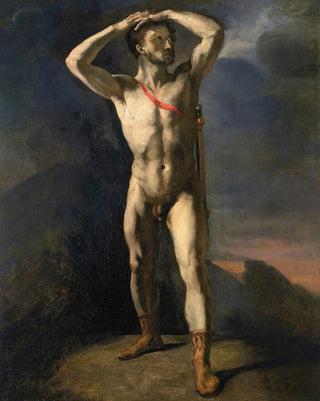Art print | Nude man academy with sword - Théodore Géricault


View from behind

Frame (optional)
Reproduction of "Académie d'homme nu au glaive" by Théodore Géricault – Captivating Introduction
The work "Académie d'homme nu au glaive" by Théodore Géricault is a true ode to the beauty and power of the human body. In this representation, the artist manages to capture not only the physical form but also the dynamics of gesture. This painting, which belongs to the Romantic movement, evokes emotional depth and intensity that resonate with the viewer. Through this art print, the work transforms into a genuine dialogue between the past and the present, allowing a rediscovery of Géricault's virtuosity within a contemporary context. The artist, through his bold approach and keen sense of aesthetics, invites us to contemplate the strength and fragility of humanity.
Style and uniqueness of the work
Géricault stands out for his masterful use of shadows and lights, creating a striking contrast that emphasizes the musculature of the model. In "Académie d'homme nu au glaive," the choice of the glaive as a symbol of strength and nobility adds an extra dimension to the composition. The artist plays with lines and shapes, offering an almost sculptural vision of the human body. The posture of the figure, both majestic and vulnerable, demonstrates a delicate balance between power and sensitivity. This work does not merely depict a nude body; it transcends the simple anatomical study to become a reflection on identity and the human condition. The viewer's gaze is inevitably drawn to the palpable tension emanating from this scene, making this art print a central piece in any art collection.
The artist and his influence
Théodore Géricault, an emblematic figure of the Romantic movement, left a mark on art history through his boldness and innovation. His career, though tragically cut short, left an indelible imprint on his contemporaries and subsequent generations. Géricault was not a passive observer of his time; he was an engaged actor, exploring themes such as suffering, passion, and the quest for freedom. His approach to subjects, often inspired by real life, paved the way for a new way of conceiving art. By focusing on

Matte finish

View from behind

Frame (optional)
Reproduction of "Académie d'homme nu au glaive" by Théodore Géricault – Captivating Introduction
The work "Académie d'homme nu au glaive" by Théodore Géricault is a true ode to the beauty and power of the human body. In this representation, the artist manages to capture not only the physical form but also the dynamics of gesture. This painting, which belongs to the Romantic movement, evokes emotional depth and intensity that resonate with the viewer. Through this art print, the work transforms into a genuine dialogue between the past and the present, allowing a rediscovery of Géricault's virtuosity within a contemporary context. The artist, through his bold approach and keen sense of aesthetics, invites us to contemplate the strength and fragility of humanity.
Style and uniqueness of the work
Géricault stands out for his masterful use of shadows and lights, creating a striking contrast that emphasizes the musculature of the model. In "Académie d'homme nu au glaive," the choice of the glaive as a symbol of strength and nobility adds an extra dimension to the composition. The artist plays with lines and shapes, offering an almost sculptural vision of the human body. The posture of the figure, both majestic and vulnerable, demonstrates a delicate balance between power and sensitivity. This work does not merely depict a nude body; it transcends the simple anatomical study to become a reflection on identity and the human condition. The viewer's gaze is inevitably drawn to the palpable tension emanating from this scene, making this art print a central piece in any art collection.
The artist and his influence
Théodore Géricault, an emblematic figure of the Romantic movement, left a mark on art history through his boldness and innovation. His career, though tragically cut short, left an indelible imprint on his contemporaries and subsequent generations. Géricault was not a passive observer of his time; he was an engaged actor, exploring themes such as suffering, passion, and the quest for freedom. His approach to subjects, often inspired by real life, paved the way for a new way of conceiving art. By focusing on






